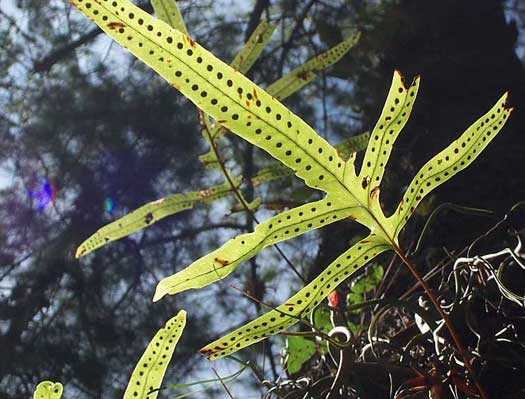Excerpts from Jim Conrad's
Naturalist Newsletter
from the November 12, 2007 Newsletter issued from Yerba Buena Clinic just outside Pueblo Nuevo Solistahuacan, Chiapas, MÉXICO
about 1740 meters in elevation, ± LAT. 17° 11' 27"N, LONG. -92° 53' 35"W
HARES-FOOT-FERN
Probably the most common and conspicuous fern growing on tree trunks and branches here is the one shown below.

That's the genus PHLEBODIUM, maybe the species AUREUM, in English sometimes it's called Hares-foot-fern.
The picture shows a sunlight illuminated frond with round "fruit-dots," or sori, clearly visible on the frond's undersurface. Sori are locations where the fern's spore-producing sporangia cluster.
It's good to see sori because they're useful in fern identification. Sori come in a bewildering variety of shapes, sizes and arrangements upon the frond's surface. When I see sori such as these -- round, with no indusium (cover over the sorus), and neatly arranged in single file -- I immediately assume that the fern is a member of the Polypody Family. If you know North America's Common Polypody or Resurrection Fern in this same family, you'll agree that Phlebodium's sori look just like theirs. In fact, Phlebodium ferns used to be placed in the genus Polypodium, to which Common Polypodies and Resurrection Ferns also belong.
Phlebodiums are robust ferns, which they must be to survive on naked tree trunks as well as in the airy, exposed tops of older trees where often you see their fronds dangling from among dense bromeliad gardens. Often I find them growing on the ground. When I probe the ground around these terrestrial ferns often I find the remnants of the old tree trunk the ferns had been climbing when the tree fell. Most epiphytes, when their tree falls, are goners. But Phlebodiums are tough enough, and flexible enough, to survive.
This heartiness may explain why horticulturalists have paid attention to the fern, for the species' fronds don't strike me as particularly pretty. One form developed from our wild kind is silvery, or "glaucous," while another's frond margins appear cut into narrow, pointed lobes.